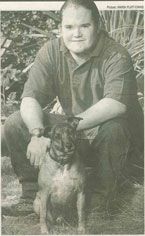Every week, eight apparently healthy, young people die from undiagnosed heart condition but many of these tragedies can be prevented. Joani Walsh reports.
On June 7, 2005 Joel Davies rushed back from work to make sure that he was at home when his Glastonbury Festival tickets was delivered. It arrived around 5pm and Joel spent the evening excitedly chatting to friends on the internet. His last message at 7.45pm read: “I’m off for a bit…be back later.”
But he never returned. Joel, who was 23, died in his sleep some time during the night and was discovered the next morning by his 18-year-old brother Jack. The coroner later recorded a verdict of death by natural causes. Two years on, his family and friends are still struggling to comet to terms with the loss of a popular and much-loved man.
“How can the unexplained death of an apparently healthy, young man ever be described as natural?” asks his mother Jane.
It is a question being asked by hundreds of families every year. In the UK, as many as eight seemingly fit and healthy young people die every week from previously undiagnosed heart disorders. When a cause of death cannot be established, sudden adult death syndrome (SADS) or sudden arrhythmia death syndrome is often cited.
“Recording that someone died of ‘natural causes’ simply means there was no foul play,” says Dr Sanjay Sharma, director of heart muscle disease at King’s College Hospital, London.
“In most instances, deaths in apparently healthy young people are due to electrical disturbances within the heart. The chances of Joel’s being a cardiac death are almost 100 per cent.”
Found in time, heart conditions such as Brugada syndrome and Long QT syndrome can be treated and lives saved.
Bradley Farrow discovered he had Brugada syndrome when he apparently fainted while working at his weekend job in a security company at the age of 16.
Fortunately, he wasn’t sitting down at the time or the episode could have been fatal.
I was standing talking to my boss when I blacked out without any warning,” explains Bradley.
“I later found out my heart had stopped. It was only the fore of my chest hitting the floor as I fell that jolted it back into action.”
Bradley, now 21, was told by doctors that he had suffered a simple fainting spell and was sent home to his parents, Eddie and Dave, with whom he still lives in Woking, Surrey.
But his mother Eddie, a retired nurse, refused to accept the diagnosis and sent her son back to hospital with the instruction that he wasn’t to be come home until they’d found out what was wrong. Doctors carried out an electrocardiogram (ECG) – which looks at the electrical tracing of the heart and passed the ‘unusual’ readings to the Royal Brompton Hospital in London.
Three weeks later came confirmation of a diagnosis of Brugada syndrome, a genetic condition which causes a disturbance in the electrical function of the heart – like a short circuit – that can cause the heart to stop beating.
After a two-month wait, Bradley underwent an operation to insert a defibrillator, an electronic box that sits under the skin is attached to the heart. The device delivers an electric shock that resets the heart when it falls out of rhythm.
It has since fired twice – on the first occasion delivering such a powerful jolt, Bradley was thrown from the bike he was riding at the time.
Since his operation, life for Bradle
y has continued as normal.
“The only difference my condition has made is that I couldn’t join the Army when I left school.
“But I loved climbing, abseiling and kayaking and I still continue to play rugby – although everyone is too scared to tackle me,” he says.
Screening for heart rhythm disorders is only available on the NHS to young people displaying symptoms of a possible underlying heart condition, such as chest pain (especially after exercise), blackouts, palpitations, breathlessness or prolonged dizziness.
Because many SADS conditions are genetic, the screening should also be offered to relatives of people who have died before the age of 40 without any warning signs, although this is not always the case.
The charity Cardiac Risk in the Young (CRY) argues that screening should be available to anyone under 35 who wants to ensure that their heart is healthy.
The charity’s Heart Screening Awareness Partnership campaign aims to increase awareness of and access to screening for young people in an attempt to reduce the number of deaths from SADS.
Clinics are open in north London, Colchester and Northern Ireland, although there are plans to open more. A mobile screening van is also available.
” We would like all young people to have the chance of being checked,” says CRY’s deputy chief executive Steve Cox, “because the first symptom of many of the conditions that fall under the SADS umbrella is often death itself.”
Joel Davies’s brothers, Josh and Jack, have been screened and proved to be healthy as far as doctors are able to determine. “It wasn’t offered, though,” says Jane. “We had to fight for it and when you’re torn up with grief, there’s hardly any fight left. But I was angry Joel died without the chance to fight.
“There’s nothing we can do to bring him back but if we could give our lives to have him back. we’d do it. In a heartbeat.”
Visit c-r-y.uk/ecg.htm for more information.







